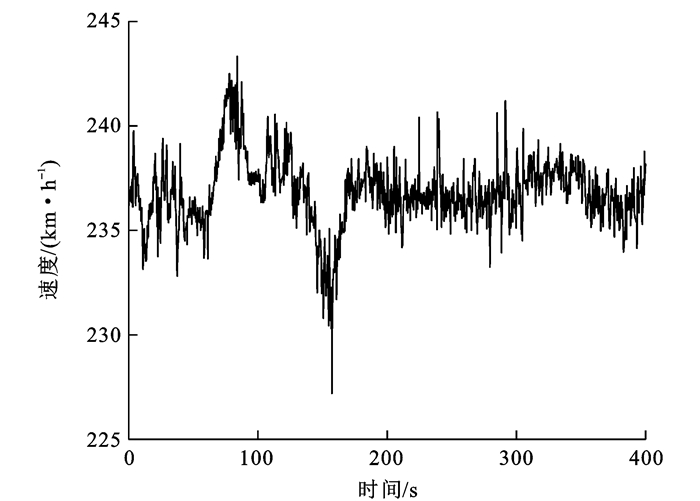Formation mechanism and progression pattern of eccentric wear of high-speed train wheels
-
摘要: 为了研究高速列车车轮偏心磨耗的形成机理,根据现场测试和多体动力学仿真结果,建立了高速列车车轮-钢轨系统有限元模型,采用瞬时动态仿真分析了车轮残余静不平衡对轮轨法向接触力的影响;对最高速度为250 km·h-1动车组列车的运营速度进行现场测试,计算了列车匀速运行区间的平均速度;基于摩擦功周期性波动引起轮轨非均匀磨耗的观点,分析了车轮残余静不平衡量对轮轨接触力的影响,研究了车轮偏心磨耗的成因;通过改变轮轨有限元模型中车轮辐板上特定区域的材料密度来模拟残余静不平衡量,研究了偏心磨耗与残余静不平衡量大小的关系;通过重新编译有限元模型节点坐标来模拟偏心磨耗后车轮踏面的真实轮廓,研究了车轮偏心磨耗的发展规律。仿真结果表明:当高速列车以237 km·h-1的速度匀速运行时,车轮残余静不平衡会引起轮轨系统发生约24 Hz的振动,导致轮轨法向接触力周期性变化,引起车轮踏面发生1阶非圆磨耗,即车轮偏心磨耗;随着磨耗的不断加深,轮轨系统约48、72 Hz的振动被激励,引起2、3阶车轮多边形磨耗;当磨耗后的车轮踏面最大径跳大于0.15 mm时,在0~150 Hz的频率范围内,72 Hz的振动强度最大,导致车轮3阶多边形磨耗迅速增加;降低车轮残余静不平衡量可减缓1阶非圆车轮的形成。Abstract: To investigate the generation mechanism of the eccentric wear of high-speed train wheels, a high-speed wheel-rail finite element model was established based on the results of a field test and multibody dynamics-based simulation, and the impacts of residual static unbalance of wheels on wheel-rail normal contact forces were analyzed by transient dynamic simulation. The field test was performed on the operational speed of a multiple-unit train with a maximum operational speed of 250 km·h-1 to determine the average speed of the train travelling in a uniform speed interval. Based on the viewpoint that the periodic fluctuations of frictional work result in uneven wheel-rail wear, the impacts of residual static unbalance of wheels on wheel-rail contact forces were analyzed, and the causes of the eccentric wear of wheels were explored. The residual static unbalance was simulated by adjusting the material density in the specific area on the wheel plate in the wheel-rail finite element model to investigate the relationship between the eccentric wear and the level of residual static unbalance. By recompiling the node coordinates in the finite element model to investigate the progression pattern of the eccentric wear of wheels, the eccentric wear of the actual wheel tread contour was simulated. Simulation results show that when the high-speed train travels at a uniform speed of 237 km·h-1, the residual static unbalance of the wheels causes the wheel-rail system to vibrate at around 24 Hz, resulting in the periodic changes in wheel-rail normal contact forces and 1-order out-of-roundness wear of the wheel tread (that is, the eccentric wear of the wheels). With the progression of the wear, the vibrations at about 48 Hz and 72 Hz are stimulated in the wheel-rail system, which causes 2- or 3-order polygonal wear of wheels. When the maximum radial runout value of the worn wheel tread is greater than 0.15 mm, the vibration intensity is the greatest at 72 Hz within the frequency range of 0-150 Hz, resulting in the rapid progression of the 3-order polygonal wear of wheels. The formation of 1-order out-of-roundness wheels can be attenuated by reducing the amount of residual static unbalance of wheels. 2 tabs, 11 figs, 29 refs.
-
表 1 质量偏心车轮-钢轨系统有限元模型参数
Table 1. Parameters of finite element model of mass eccentric wheel-rail system
参数名称 符号 数值 一系垂向悬挂力 F1/kN 68.358 一系横向悬挂力 F2/kN 0 轮轨间摩擦系数 μ 0.23 区域E与车轮的中心距 r/m 0.29 轨枕间距 LS/m 0.629 区域E的体积 VE/m3 0.000 169 区域E的材料密度 ρE/(kg·m-3) 8 834.633 车轮和钢轨的材料密度 ρ/(kg·m-3) 7 800.000 车轮和钢轨的杨氏模量 e/MPa 210 000 车轮和钢轨的泊松比 p 0.3 扣件垂向刚度 K1/(MN·m-1) 50 扣件横向刚度 K2/(MN·m-1) 28 扣件垂向阻尼 C1/[N·(m·s-1)-1] 30 扣件横向阻尼 C2/[N·(m·s-1)-1] 20 表 2 车轮不同残余静不平衡量对应的区域E密度
Table 2. Area E's densities corresponding to different wheel residual static unbalance values
|U|/(g·m) ρE/(kg·m-3) 0 7 800.000 10 8 018.760 20 8 222.729 30 8 426.697 40 8 630.665 50 8 834.633 -
[1] 朱海燕, 胡华涛, 尹必超, 等. 轨道车辆车轮多边形研究进展[J]. 交通运输工程学报, 2020, 20(1): 102-119. doi: 10.19818/j.cnki.1671-1637.2020.01.008ZHU Hai-yan, HU Hua-tao, YIN Bi-chao, et al. Research progress on wheel polygons of rail vehicles[J]. Journal of Traffic and Transportation Engineering, 2020, 20(1): 102-119. (in Chinese) doi: 10.19818/j.cnki.1671-1637.2020.01.008 [2] WANG Bin-jie, XIE Shu-qiang, JIANG Chao-yong, et al. An investigation into the fatigue failure of metro vehicle bogie frame[J]. Engineering Failure Analysis, 2020, 118: 104922. doi: 10.1016/j.engfailanal.2020.104922 [3] SHEN Xun-liang, LU Lian-tao, ZENG Dong-fang. Fatigue failure analysis of high strength bolts used for high-speed railway vehicle braking discs[J]. Engineering Failure Analysis, 2020, 115: 104661. doi: 10.1016/j.engfailanal.2020.104661 [4] CHEN Mei, SUN Yu, GUO Yu, et al. Study on effect of wheel polygonal wear on high-speed vehicle-track-subgrade vertical interactions[J]. Wear, 2019, 432/433: 102914. doi: 10.1016/j.wear.2019.05.029 [5] WU Hao, WU Ping-bo, LI Fan-song, et al. Fatigue analysis of the gearbox housing in high-speed trains under wheel polygonization using a multibody dynamics algorithm[J]. Engineering Failure Analysis, 2019, 100: 351-364. doi: 10.1016/j.engfailanal.2019.02.058 [6] WU Xing-wen, RAKHEJA S, QU Sheng, et al. Dynamic responses of a high-speed railway car due to wheel polygonalisation[J]. Vehicle System Dynamics, 2018, 56(12): 1817-1837. doi: 10.1080/00423114.2018.1439589 [7] SHAN Wei, WU Ping-bo, WU Xing-wen, et al. Effect of wheel polygonization on the axle box vibrating and bolt self-loosening of high-speed trains[J]. Journal of Physics: Conference Series, 2019, 1213(5): 052044. doi: 10.1088/1742-6596/1213/5/052044 [8] WANG Zhi-wei, MEI Gui-ming, ZHANG Wei-hua, et al. Effects of polygonal wear of wheels on the dynamic performance of the gearbox housing of a high-speed train[J]. Proceedings of the Institution of Mechanical Engineers, Part F: Journal of Rail and Rapid Transit, 2018, 232(6): 1852-1863. doi: 10.1177/0954409717752998 [9] WANG Ping, LU Jun, ZHAO Cai-you, et al. Numerical investigation of the fatigue performance of elastic rail clips considering rail corrugation and dynamic axle load[J]. Proceedings of the Institution of Mechanical Engineers, Part F: Journal of Rail and Rapid Transit, 2021, 235(3): 339-352. doi: 10.1177/0954409720926016 [10] KAEWUNRUEN S, REMENNIKOV A M. Effect of a large asymmetrical wheel burden on flexural response and failure of railway concrete sleepers in track systems[J]. Engineering Failure Analysis, 2008, 15(8): 1065-1075. doi: 10.1016/j.engfailanal.2007.11.013 [11] 吴磊, 钟硕乔, 金学松, 等. 车轮多边形化对车辆运行安全性能的影响[J]. 交通运输工程学报, 2011, 11(3): 47-54. doi: 10.3969/j.issn.1671-1637.2011.03.009WU Lei, ZHONG Shuo-qiao, JIN Xue-song, et al. Influence of polygonal wheel on running safety of vehicle[J]. Journal of Traffic and Transportation Engineering, 2011, 11(3): 47-54. (in Chinese) doi: 10.3969/j.issn.1671-1637.2011.03.009 [12] BROMMUNDT E. A simple mechanism for the polygonalization of railway wheels by wear[J]. Mechanics Research Communications, 1997, 24(4): 435-442. doi: 10.1016/S0093-6413(97)00047-5 [13] MORYS B. Enlargement of out-of-round wheel profiles on high speed trains[J]. Journal of Sound and Vibration, 1999, 227(5): 965-978. doi: 10.1006/jsvi.1999.2055 [14] MEYWERK M. Polygonalization of railway wheels[J]. Archive of Applied Mechanics, 1999, 69(2): 105-120. doi: 10.1007/s004190050208 [15] MEINKE P, MEINKE S. Polygonalization of wheel treads caused by static and dynamic imbalances[J]. Journal of Sound and Vibration, 1999, 227(5): 979-986. doi: 10.1006/jsvi.1999.2590 [16] SNYDER T, STONE D H, KRISTAN J. Wheel flat and out-of round formation and growth[C]//IEEE. Proceedings of the 2003 IEEE/ASME Joint Railroad Conference. New York: IEEE, 2003: 143-148. [17] JOHANSSON A. Out-of-round railway wheels—assessment of wheel tread irregularities in train traffic[J]. Journal of Sound and Vibration, 2006, 293(3/4/5): 795-806. [18] TSAI M S, CHEN S K. Analysis of high-speed railway vehicle trucks with worn and eccentric wheelset moving on curved tracks[J]. Journal of the Chinese Society of Mechanical Engineers, 2011, 32(4): 331-340. [19] WANG Yong, KANG Hong-jun, SONG Xiao-wen, et al. Influence of dynamic unbalance of wheelsets on the dynamic performance of high-speed cars[J]. Journal of Modern Transportation, 2011(3): 147-153. [20] JIN Xue-song, WU Lei, FANG Jian-ying, et al. An investigation into the mechanism of the polygonal wear of metro train wheels and its effect on the dynamic behaviour of a wheel/rail system[J]. Vehicle System Dynamics, 2012, 50(12): 1817-1834. doi: 10.1080/00423114.2012.695022 [21] 刘启跃, 张波, 周仲荣, 等. 滚动轮波形磨损实验研究[J]. 摩擦学学报, 2003, 23(2): 132-135. doi: 10.3321/j.issn:1004-0595.2003.02.013LIU Qi-yue, ZHANG Bo, ZHOU Zhong-rong, et al. Experimental study on rolling wheel corrugation[J]. Tribology, 2003, 23(2): 132-135. (in Chinese) doi: 10.3321/j.issn:1004-0595.2003.02.013 [22] 马卫华, 罗世辉, 宋荣荣. 地铁车辆车轮多边形化形成原因分析[J]. 机械工程学报, 2012, 48(24): 106-111. https://www.cnki.com.cn/Article/CJFDTOTAL-JXXB201224019.htmMA Wei-hua, LUO Shi-hui, SONG Rong-rong. Analyses of the form reason of wheel polygonization of subway vehicle[J]. Journal of Mechanical Engineering, 2012, 48(24): 106-111. (in Chinese) https://www.cnki.com.cn/Article/CJFDTOTAL-JXXB201224019.htm [23] TAO Gong-quan, WEN Ze-feng, LIANG Xi-ren, et al. An investigation into the mechanism of the out-of-round wheels of metro train and its mitigation measures[J]. Vehicle System Dynamics, 2019, 57(1): 1-16. doi: 10.1080/00423114.2018.1445269 [24] 陈光雄, 金学松, 邬平波, 等. 车轮多边形磨耗机理的有限元研究[J]. 铁道学报, 2011, 33(1): 14-18. doi: 10.3969/j.issn.1001-8360.2011.01.003CHEN Guang-xiong, JIN Xue-song, WU Ping-bo, et al. Finite element study on the generation mechanism of polygonal wear of railway wheels[J]. Journal of the China Railway Society, 2011, 33(1): 14-18. (in Chinese) doi: 10.3969/j.issn.1001-8360.2011.01.003 [25] 陈光雄, 崔晓璐, 王科. 高速列车车轮踏面非圆磨耗机理[J]. 西南交通大学学报, 2016, 51(2): 244-250. doi: 10.3969/j.issn.0258-2724.2016.02.004CHEN Guang-xiong, CUI Xiao-lu, WANG Ke. Generation mechanism for plolygonalization of wheel treads of high-speed trains[J]. Journal of Southwest Jiaotong University, 2016, 51(2): 244-250. (in Chinese) doi: 10.3969/j.issn.0258-2724.2016.02.004 [26] 赵晓男, 陈光雄, 崔晓璐, 等. 高速列车车轮多边形磨耗的形成机理及影响因素探究[J]. 表面技术, 2018, 47(8): 8-13. https://www.cnki.com.cn/Article/CJFDTOTAL-BMJS201808002.htmZHAO Xiao-nan, CHEN Guang-xiong, CUI Xiao-lu, et al. Formation mechanism and influencing factors of the polygonal wear of high-speed train wheels[J]. Surface Technology, 2018, 47(8): 8-13. (in Chinese) https://www.cnki.com.cn/Article/CJFDTOTAL-BMJS201808002.htm [27] WU Yue, DU Xing, ZHANG He-ji, et al. Experimental analysis of the mechanism of high-order polygonal wear of wheels of a high-speed train[J]. Journal of Zhejiang University-SCIENCE A (Applied Physics and Engineering), 2017, 18(8): 579-592. doi: 10.1631/jzus.A1600741 [28] BROCKLEY C A, KO P L. An investigation of rail corrugation using friction-induced vibration theory[J]. Wear, 1988, 128(1): 99-106. doi: 10.1016/0043-1648(88)90256-6 [29] 金学松, 吴越, 梁树林, 等. 高速列车车轮多边形磨耗、机理、影响和对策分析[J]. 机械工程学报, 2020, 56(16): 118-136. https://www.cnki.com.cn/Article/CJFDTOTAL-JXXB202016014.htmJIN Xue-song, WU Yue, LIANG Shu-lin, et al. Characteristics, mechanism, influences and countermeasures of polygonal wear of high-speed train wheels[J]. Journal of Mechanical Engineering, 2020, 56(16): 118-136. (in Chinese) https://www.cnki.com.cn/Article/CJFDTOTAL-JXXB202016014.htm -





 下载:
下载:












